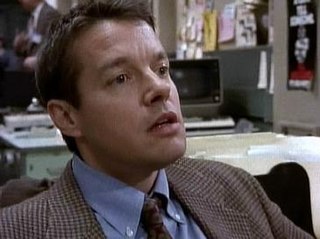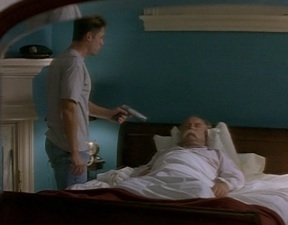Homicide: Life on the Street is an American police drama television series chronicling the work of a fictional version of the Baltimore Police Department's Homicide Unit. It ran for seven seasons and 122 episodes on NBC from January 31, 1993, to May 21, 1999, and was succeeded by Homicide: The Movie (2000), which served as the series finale. The series was created by Paul Attanasio and based on David Simon's book Homicide: A Year on the Killing Streets (1991). Many of the characters and stories used throughout the show were based on events depicted in the book.

Det. Steven Crosetti is a fictional character on the television drama series Homicide: Life on the Street portrayed by actor Jon Polito for the show's first two seasons. He is believed to be based on Baltimore Police Department Detective Sergeant Terry McLarney, who was a squad supervisor in the BPD homicide unit in David Simon's book Homicide: A Year on the Killing Streets; the character's ancestry was changed from Irish to Italian because Polito got the role.

The first season of Homicide: Life on the Street, an American police procedural drama television series, originally aired in the United States on NBC between January 31 and March 31, 1993. The show was created by Paul Attanasio, with film director Barry Levinson and television writer and producer Tom Fontana serving as executive producers. Adapted from David Simon's 1991 non-fiction book Homicide: A Year on the Killing Streets, the season followed the fictional detectives of Baltimore Police Department homicide unit and the murder cases they investigate. The show was broadcast on Wednesdays at 9 p.m. EST, with the exception of the series premiere, which aired immediately after Super Bowl XXVII.

Timothy Bayliss is a fictional character on Homicide: Life on the Street, played by Kyle Secor and one of the few main characters to last the entire run of the show. He was loosely based on real-life Baltimore homicide detective Thomas Pellegrini, featured in David Simon's book Homicide: A Year on the Killing Streets, though Pellegrini was reportedly not at all a fan of his fictional alter ego. The character also appeared in the Law & Order episode "Charm City."

The second season of Homicide: Life on the Street, an American police procedural drama television series, originally aired in the United States between January 6 and January 27, 1994. Due to low Nielsen ratings during the first season, NBC executives decided to order only a four-episode season, after which they would evaluate the ratings and decide whether to renew the show. Homicide was moved to a new timeslot of Thursdays at 10 p.m. EST, temporarily replacing the legal drama L.A. Law. NBC requested several changes from the series, including fewer episode subplots and less camera movements and jump cuts.
"Blood Ties" is the three-episode sixth season premiere of the American police drama television series Homicide: Life on the Street. The episodes constitute the 78th, 79th and 80th overall episodes of the series. They originally aired on NBC on October 17, 24 and 31, 1997, respectively.

"Gone for Goode" is the first episode of the first season of the American police drama television series Homicide: Life on the Street. It originally aired on NBC in the United States on January 31, 1993, immediately following Super Bowl XXVII. The episode was written by series creator Paul Attanasio and directed by executive producer Barry Levinson. "Gone for Goode" introduced regular cast members Daniel Baldwin, Ned Beatty, Richard Belzer, Andre Braugher, Wendy Hughes, Clark Johnson, Yaphet Kotto, Melissa Leo, Jon Polito, and Kyle Secor.

"Three Men and Adena" is the fifth episode of the first season of the American police drama television series Homicide: Life on the Street. It originally aired on NBC in the United States on March 3, 1993. The episode was written by executive producer Tom Fontana and directed by Martin Campbell. In the episode, Pembleton and Bayliss have a 12-hour limit to elicit a confession from Risley Tucker for the murder of 11-year-old Adena Watson. The episode takes place almost entirely within the confines of the police interrogation room with the three actors.
"Ghost of a Chance" is the second episode of the first season of the American police drama television series Homicide: Life on the Street. It originally aired on NBC in the United States on February 3, 1993. The teleplay was written Noel Behn based on a story by executive producer Tom Fontana, and the episode was directed by Martin Campbell. In it Bayliss begins his investigation into the murder of 11-year-old Adena Watson, Munch and Bolander investigate the unusual death of an elderly man, and Howard insists she is receiving advice about her murder case from a ghost.

"Son of a Gun" is the third episode of the first season of the American police drama television series Homicide: Life on the Street. It originally aired on NBC in the United States on February 10, 1993. The teleplay was written by James Yoshimura based on a story by executive producer Tom Fontana, and the episode was directed by Nick Gomez. In the episode, recurring character Officer Thormann is shot while on duty, and his close friend Crosetti takes the investigation personally.

"A Shot in the Dark" is the fourth episode of the first season of the American police drama television series Homicide: Life on the Street. It originally aired on NBC in the United States on February 24, 1993. The teleplay was written by Jorge Zamacona based on a story by executive producer Tom Fontana, and the episode was directed by Bruce Paltrow. In the episode, Crosetti focuses his investigation into the shooting of Officer Thormann on one suspect, while Lewis continues to investigate. Meanwhile, Pembleton and Bayliss pursue different leads in the murder case of 11-year-old Adena Watson.
"And the Rockets' Dead Glare" is the seventh episode of the first season of the American police drama television series Homicide: Life on the Street. It originally aired on NBC in the United States on March 17, 1993. In the episode, Howard testifies in a murder trial, Pembleton is offered a promotion, and Lewis and Crosetti go to the Chinese Embassy in Washington, D.C. to investigate a political refugee's murder.

"Smoke Gets in Your Eyes" is the eighth episode of the first season of the American police drama television series Homicide: Life on the Street. It originally aired on NBC in the United States on March 24, 1993. In the episode, Howard and Bayliss attempt to quit smoking, Gee discovers secret asbestos removal in the squad room, and Munch and Bolander investigate the beating death of a 14-year-old boy. The episode was written by James Yoshimura and Tom Fontana, and was directed by Wayne Ewing, who doubled as director of photography.

"Night of the Dead Living" is the ninth episode and first season finale of the American police drama television series Homicide: Life on the Street. It originally aired on NBC in the United States on March 31, 1993. In the episode, the homicide squad works the night shift on a summer evening, but no calls come in, leaving the detectives to brood over their personal matters. The teleplay was written by Frank Pugliese based on a story he wrote along with executive producer Tom Fontana. It was directed by Michael Lehmann.
"Law & Disorder" is the 15th episode of the third season of the American police drama television series Homicide: Life on the Street. It originally aired on NBC on February 24, 1995. The episode was written by Bonnie Mark and Julie Martin and directed by John McNaughton. The episode concludes elements of a storyline about the shooting of Beau Felton, Kay Howard, and Stanley Bolander.

"A Many Splendored Thing" is the second season finale of the American police drama television series Homicide: Life on the Street, and the thirteenth overall episode of the series. It originally aired on NBC in the United States on January 27, 1994. In the episode, Pembleton and Bayliss investigate the S&M-related murder of a young woman, which forces an uncomfortable Bayliss to confront his darker side. Meanwhile, Lewis is disturbed when a man commits murder over a $1.49 pen, and a despairing Munch crashes Bolander's date and ruins it by venting his own romantic woes.

"See No Evil" is the second episode of the second season of the American police drama television series Homicide: Life on the Street, and the eleventh overall episode of the series. It originally aired on NBC in the United States on January 13, 1994. In the episode, Felton's friend kills his father in an assisted suicide, and Felton tries to convince Lewis to look the other way. In a subplot, Pembleton investigates what appears to be the police shooting of an unarmed suspect.
"Black and Blue" is the third episode of the second season of the American police drama television series Homicide: Life on the Street, and the twelfth overall episode of the series. It originally aired on NBC in the United States on January 20, 1994. In the episode, Pembleton aggressively investigates what he believes to be a police-related shooting. Amid pressure from Gee to pursue civilian suspects, Pembleton elicits a successful confession from an innocent man, leaving Gee feeling conflicted. Directed by Chris Menaul, the episode's teleplay was written by James Yoshimura based on a story by series executive producer Tom Fontana.
"Nearer My God to Thee" is the third season premiere of the American police drama television series Homicide: Life on the Street, and the fourteenth overall episode of the series. It originally aired on NBC in the United States on October 14, 1994. In the episode, the homicide department is assigned to the politically volatile murder of a beloved social worker, whose body is found wearing nothing but a pair of white gloves. Meanwhile, Felton struggles with marital problems, while Lewis and Munch try to find a business partner with whom to open a bar.
"Fire" is the season premiere of the fourth season of the American police drama television series Homicide: Life on the Street. It originally aired on NBC on October 20, 1995. The episode was written by Julie Martin and was directed by Tim Hunter. The two-part story centres on Pembleton and Bayliss' investigation into a pair of arson-related homicides, and introduces a new regular character, Arson Squad detective Mike Kellerman, who subsequently transfers to Homicide and partners with Det. Meldrick Lewis. This episode also flagged the permanent departure of regular characters Stanley Bolander and Beau Felton.












